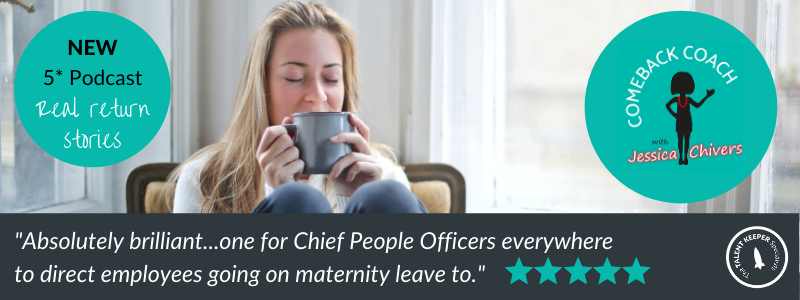Why voice memos are my M.O. for including people during a pandemic

Right now, people on long leave and those working remotely risk feeling more alienated than ever before. I’m hearing coachees say they are overwhelmed, anxious and exhausted.
We’re here to help you give employees a sense of security and connection so they can hit the ground running when they return. Here we explain how line managers can help all employees feel included. We’re also sharing advice for remote workers and employees on long-term leave to ensure they don’t get left behind.
How are people feeling working from home?
My coachees are feeling huge amounts of self-doubt. People are physically tired from video calls. They are worried about how they are being perceived, concerned if they haven’t spoken up, or feeling like their comments haven’t landed well.
Working virtually, we don’t get the affirmatory cues that go beyond the task in hand. In normal circumstances, everyone would have drifted out of the meeting and enjoyed a light-hearted conversation that would have put any concerns to bed.
I’m alarmed at the number of people who tell me they don’t leave the house for days and delighted that Channel 4 CEO Alex Mahon has mandated a daily communal 90-minute screen-free lunch break to combat pandemic fatigue.

It’s really important to notice the difference between inclusion and belonging
If ‘inclusion’ activities are the actions a line manager or organisation might take with the goal of making someone feel like they belong, ‘belonging’ is the individual’s subjective experience of that. Just because you have rolled out inclusion activities it does not mean each individual will feel them. It’s about knowing your team and responding individually to their needs.
How can line managers know what lands best with individual team members?
Being away from the physical office gives everyone time to reflect. Now is a great time to ask for honest, considered feedback from your employees. You’ll foster stronger working relationships with them and gain a better understanding of what they respond to as individuals.
You could approach this in a 1:1 meeting in this way:
“In our conversations in the past, is there anything I’ve said or done that has really resonated with you? Or anything that has grated?” “Is there anything I have done in the past 12 months that you have particularly liked? Or disliked?”
Voice memos are a nifty way to give praise and connect
My advice for line managers is not to give praise over email or a phone call. I think a voice memo is a lovely way for someone to express themselves. It’s offered without pressure for the receiver to respond in the moment. A voice memo can be listened to a few times and the receiver will hear the real sincerity in your voice. You could simply tell them about something that reminded you of them and let them know they are in your thoughts. You can do that with the people in your team now too.
- Why not send a voice memo to someone on long term leave today? Point them in the direction of my new and uplifting ‘wobbly-bottomed podcast about kickass comebacks, Comeback Coach. I recently interviewed the frankly wonderful Caroline Flanagan, lawyer, mother of four and author of Babyproof Your Life. She shares how to use imposter syndrome to make you stronger (yes, really!)

Directly relate the individual’s actions to wider company success
Pan out, regularly. That is, remind your remote team how the work they have been doing as individuals has contributed to the company’s mission, or helped the frontline customer. It is easy to lose sight of that when you’re working alone. Reconnect them to wider company goals or purpose.
Bang the drum
Sticking to a regular drumbeat of communications helps both line manager and employee. Set up a schedule before a team member leaves and you’ll find it easy to stick to.
- HR leaders: Head over to our digital Comeback Community™ employee experience which supports employees before they go, during their leave and up to year after they return. It helps equip people with a communications plan.
What can you do if you are working remotely and struggling to connect with a colleague?
Why not suggest you go for a walk or a run together. Perhaps you have young children and are trying to homeschool them, while they are totally absorbed in work? A relaxed conversation – crucially, while you are engaged in another activity (the walk or run) – will break down barriers.

What should you do if you’re on long-term leave and want to reconnect?
While Keeping In Touch (KIT) days aren’t happening in reality, ask to join meetings and conversations in a listening capacity so that you can soak it all up without having to contribute. Sink into work mode for a day, read the latest documentation and enjoy the change of pace from your life at home, whether you are usually knee-deep in nappies or caring for a relative. It won’t be nearly as intimidating as you might fear.
Get in touch with your key clients and suggest meeting for a 45-minute walk if they are within striking distance. Commit to it whatever the weather! This out of work meeting will set up a great foundation for future relationships.
Returning to work after maternity leave, nine months in to a pandemic
It is hard to go from 0-100mph overnight so a phased return to work is something I strongly recommend. Nine months into the pandemic, some mothers are coming back from maternity leave to a whole new world. You may have left the workplace as normal in early March 2020 and now have to get to grips with working entirely virtually, managing all the technological developments that the rest of the team has had nine months to master.
Let us know how you get on. E-mail jc@talentkeepers.co.uk or find us on Twitter and Instagram @talentkeepersuk.
